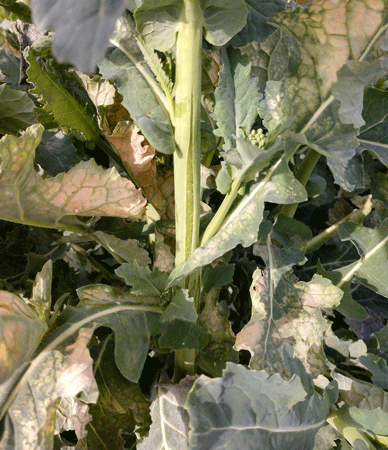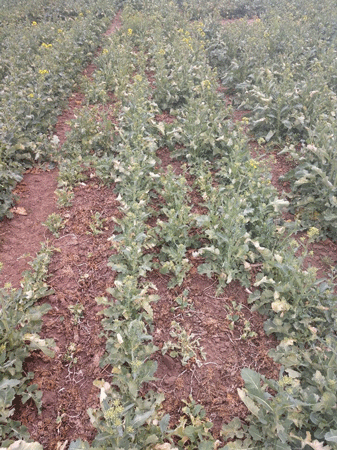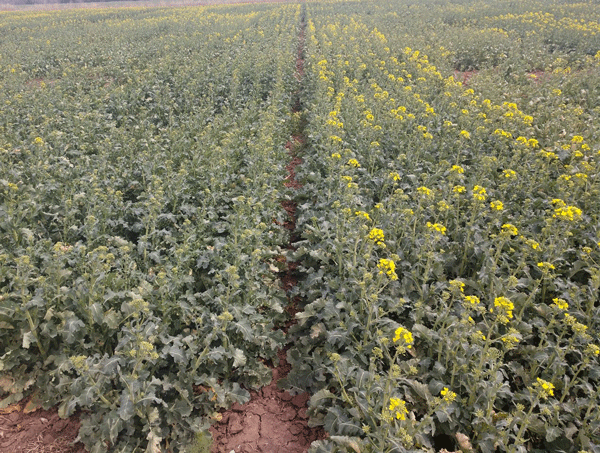Over the years, we have observed the effects of spring freezes on canola at the bolting and flowering stages. We can draw on these experiences to understand how the recent hard freeze might impact the crop. The extent of the damage will ultimately depend on several factors, including the low temperature reached, the amount of time below freezing, the growth stage of the crop, and other environmental factors such as soil moisture and exposure to the wind.
Some of the common damages to hard freeze include:
- leaf discoloration and loss,
- stem cracking and splitting,
- bud, flower, and pod loss, and
- plant lodging.
In some instances, the crop may suffer a yield penalty because the extent of the damage is too severe to overcome. In other instances, growing conditions afterward allow the crop to produce more flower buds, flowers, and seed pods; thus, a yield penalty is not observed. Canola is indeterminate (continues to flower and produce seed pods for an extended period), and because of this, it has numerous growing points on the plant. These growing points can develop new flowering sites to compensate for damaged ones when stresses occur.
The growth stage can affect the extent of crop damage depending on how low and how long temperatures are below freezing. Canola is most tolerant to freezing temperatures in the rosette stage prior to green-up and more susceptible in the bolting, flowering, and pod-filling stages. This year, canola was in the bolting to early-flowering stages across the state when temperatures dropped into the middle teens and 20s in central Kansas. At these stages, we have seen canola recover from freezes in the mid-20s, lasting for 3 to 7 hours with little substantive damage. However, temperatures below 20 for any extended period of time can be very damaging.
On March 26 and 27, temperatures at the South Central Experiment Field near Hutchinson dropped below 24 for 8 hours, with a low of 14. The chances of observing freeze injury were quite high with the canola crop at the early reproductive stage. Thus, what will the impacts of the freeze be this year?
Indicators of injury to spring freeze in canola
Leaf discoloration or bleaching is often observed at any growth stage following a spring freeze. The plant can easily tolerate some leaf discoloration without slowing new biomass development. However, the damage is likely severe if the crop does not return to normal growth after the freeze and turns pale green, white, or brown.
Discoloration is most evident on leaf tissue and, to a lesser extent, on the stem (Figure 1). Sometimes, stems and flower buds turn pale green or purple, a symptom of cold temperatures that does not necessarily indicate tissue damage. This was not observed.
Stem cracking was observed in early flowering varieties (Figure 1). Even if the stem cracks, the canola plant should continue to grow normally. Splitting occurs when the stem fills up with ice and ruptures. If the stem splits completely open, it may result in the plant eventually falling over. Severe freeze injury occurs when stems are translucent and mushy. This was not observed in Hutchinson. Cracked and split stems can become entry points for fungal decay. It is too early to determine if the stem cracking will result in weakening, disease issues, or yield loss.

Figure 1. Leaf discoloration and stem cracking were present on April 1 in winter canola plots near Hutchinson, KS after the recent spring freezes. Photo by Mike Stamm, K-State Research and Extension.
One observation is that the recent freeze severely impacted canola varieties with poor winter survival and weakened stems (Figure 2). Initially, the plants were physically damaged by fluctuating winter temperatures, causing decay of vascular tissues, and there was also a greater loss of overwintering biomass. The freeze will negatively impact these varieties because there is insufficient vascular tissue and biomass for normal plant development.

Figure 2. This variety is more susceptible to winterkill and shows negative impacts from the spring freeze. Photo by Mike Stamm, K-State Research and Extension.
At the flowering stage, we often see a bend or crook in the stem and flowering racemes. Often, these bends may take the flowering racemes to the ground; however, we have seen plants straighten and continue flowering normally. The only problem may be the racemes set seed below the main canopy of pods, potentially creating problems at harvest. The crop at Hutchinson was not far enough along in flowering for the freeze to drop flowering racemes to ground level.
After any spring freeze event, blank areas will likely be observed on flowering racemes. In severe cases, we have seen the main raceme and some secondary branches completely freeze off and die. However, the crop can compensate for the losses with secondary branching. Blank areas on flowering racemes will eventually be observed in Hutchinson, but the impact should be minimal.
Plants with later flowering can typically overcome spring freeze events because they are in a slightly more tolerant plant growth stage, i.e., bolting. Axillary buds are still being developed. Earlier flowering varieties can be more susceptible because they may be too far along to develop any new flowering clusters within a reasonable amount of time. Generally, varieties with greater winter hardiness and tolerance to winter decline syndrome can handle spring freezes better. This is because their vascular tissues had not been compromised before the freeze events occurred. In Hutchinson, there was no big difference in tolerance to freeze between genotypes that differed in earliness to flower (Figure 3).

Figure 3. Differences in earliness to flower did not have much of an impact on tolerance to freeze at Hutchinson. Photo by Mike Stamm, K-State Research and Extension.
Long-term impact of freeze damage
Repeated freeze events and longer durations of temperatures in the mid-20s may increase the severity of damage. The extent of damage and potential yield loss relative to how long it stays cold is somewhat of an unknown. However, as long as the plants show normal growth following freeze events, reasonable yields can be expected. The longer it takes the plants to recover may also indicate how severe the freeze impacts were.
Longer-term effects on the crop include differential maturity, delayed maturity, and reduced plant height. Differential maturity may occur if the freeze isn’t quite severe enough to kill the plant completely and favorable conditions cause a secondary bloom to occur. Delayed crop maturity results in flowering and grain filling during a warmer period, which can reduce yield if temperatures are above 90. Yield reductions should be minimized if temperatures remain cool during flowering and early grain fill. Reduced plant height doesn’t necessarily result in reduced yield but may reduce the amount of biomass that is available for photosynthesis.
The indeterminate growth habit still gives canola an opportunity to compensate for lost yield. How well the crop yields will be a function of the weather over the next few weeks.
Mike Stamm, Canola Breeder
mjstamm@ksu.edu
Tags: canola freeze injury winter canola